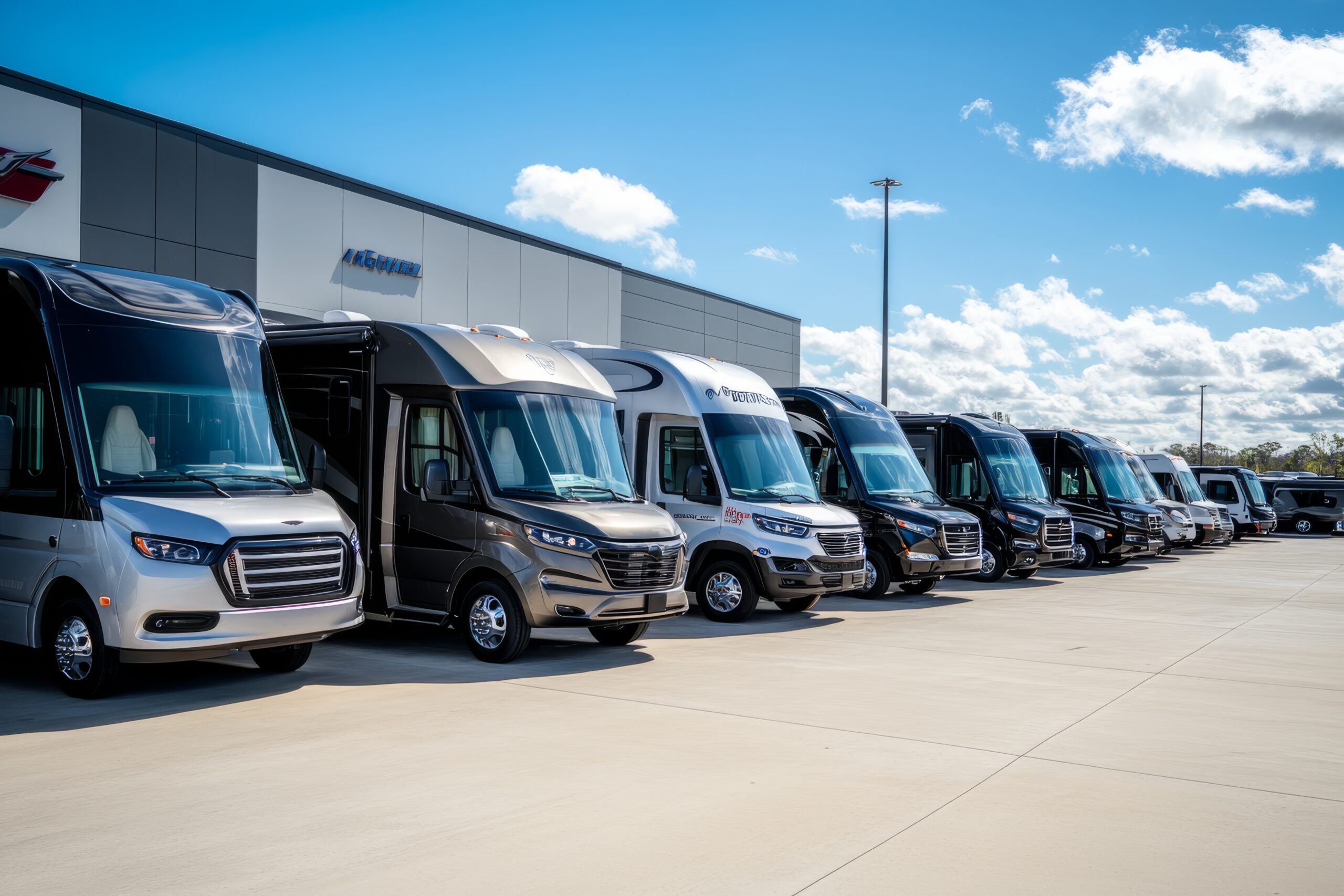If you’ve been following our most recent series of articles, you’ve heard the importance of dealer inventory management. Not only can improving your dealer management system provider help current operations and sales, but it can also increase dealership valuation when you go to sale.
That’s why here, in our next guide, we’ll be diving deep into actually how to improve your inventory management systems with the top strategies that boost value in today’s market. So, keep reading to learn about the five best practices for improving this crucial area of operations.
The Top 5 Dealer Inventory Management Strategies That Boost Dealership Valuation
When it comes to RV dealership values, it’s not always about the next best trend. It’s about timeless strategies that are proven to boost overall success at sale. Whether you’re thinking of engaging in a dealership buy-sell transaction soon or down the road, here are the five best practices for dealer inventory management strategies that’ll boost your dealership valuation overall.

1. Data-Driven Selection
In today’s world of algorithms and user information capture, we’ve never known more about the consumer and what they’re searching for purchase-wise. Using these innovative analytics to guide your inventory selection will turn guessing the new trends into strategic decision-making for inventory.
Dealerships can better forecast which RV models, boat types, or powersport vehicles will move quickly in their specific market based on gathering information on:
- Seasonal trends
- Regional preferences
- Historical sales data
- Google search trends
Dealers who adopt predictive analytics tools will have the information to identify emerging trends before competitors, allowing them to stock the right mix of in-demand units. Overall, this proactive approach significantly reduces flooring costs while maximizing inventory turnover. – two driving factors of valuation at sale.
Beyond the operational benefits, the financial impact is substantial: reduced carrying costs, decreased depreciation losses, and improved cash flow. Lenders and potential buyers view data-driven inventory practices as evidence of sophisticated management and reduced risk.
2. Strategic Off-Season
Using your off-season strategically is another desirable trait to future purchasers at sale. An automated or implemented process of strategically acquiring inventory during off-peak seasons represents a powerful valuation-building approach, especially for specialty vehicle dealerships.
Rather than following the industry’s typical buying cycles, forward-thinking dealers secure inventory when competitors aren’t buying—obtaining better wholesale prices, preferred allocation of limited production models, and favorable financing terms. This counter-cyclical purchasing strategy allows dealerships to maintain healthy margins when selling during peak seasons.
For example, acquiring boats in fall/winter for spring/summer sales can yield 10-15% higher margins. While this strategy does require sufficient capital and storage capacity, it demonstrates to potential buyers that management understands market cycles and can execute sophisticated inventory strategies.
As for dealership valuation, experts particularly favor dealerships that consistently apply this approach across multiple seasons, as it indicates disciplined operations and strategic foresight rather than reactive inventory management.
3. Dynamic Pricing
As for pricing as a part of dealer inventory management, dynamic models can dramatically enhance a dealership valuation by optimizing pricing based on real-time market conditions, inventory age, and demand fluctuations. Unlike static pricing approaches, this strategy involves sophisticated software that adjusts pricing daily or weekly based on multiple factors—
- Competitor pricing
- Days in inventory
- Seasonal demand shifts
- Even weather patterns (particularly important for recreational vehicles).
These advanced systems will automatically identify units that could benefit from price adjustments to prevent aging inventory while also maintaining optimal margins on in-demand models. Dealerships that implement this type of pricing are shown to achieve higher gross profits while significantly reducing average inventory days.
From a valuation perspective, this dealer inventory management strategy demonstrates sophisticated operational practices and creates more predictable cash flows. Potential buyers value the reduced risk profile and technological sophistication, typically assigning premium multiples to dealerships with established dynamic pricing systems integrated with their inventory management processes.
4. Balancing New-Used
Another balance to achieve to boost your dealership’s valuation is maintaining a balance between new and pre-owned inventory. This strategy increases your dealership’s value by creating complementary revenue streams that buffer market volatility. I.e., your dealership can better withstand fluctuations in recreational consumer spending.
The ideal mix—typically 60% new and 40% pre-owned for most recreational vehicle sectors—allows dealerships to capture different customer segments while hedging against manufacturing disruptions or economic downturns. It’s important to know that, in general, pre-owned inventory provides higher margins and faster turns, while new inventory drives service revenue and manufacturer incentives.
The most sophisticated dealerships often use the trade-in pipeline to source premium pre-owned units cost-effectively. Of course, while doing so, they maintain rigorous maintenance checks and reconditioning standards that maintain brand reputation while still controlling costs.
This balanced approach demonstrates to potential buyers that the dealership isn’t overly dependent on manufacturer allocations or vulnerable to new inventory financing challenges. Valuation experts typically assign premium multiples to dealerships, maintaining consistent new-used ratios that maximize overall return on investment while minimizing floor plan expenses and obsolescence risk.
5. Inventory + F&I
Lastly, integrating your inventory with finance and insurance offerings can also boost your RV dealership valuation beyond traditional floor planning approaches. This integration involves tailoring F&I products specifically to inventory aging profiles—offering more aggressive financing or enhanced warranty packages on aging units while maintaining premium F&I offerings on fast-turning inventory.
The dynamic systems typically use inventory age thresholds to trigger specific F&I promotion packages, creating a systematic approach to moving slower inventory without resorting to margin-eroding discounts.
As for valuation, this strategy represents an advanced operational integration that supports streamlined revenue from the same inventory investment. Potential dealership buyers also value this strategy because it shows management’s ability to extract maximum value from inventory assets while maintaining strong gross margins across departments.
Finding a Dealership Advisor to Plan for Future Sale
In today’s world of heightened mergers and acquisitions and cutthroat competition, it’s never too early to begin working with a dealership advisor to plot and plant your next move. Whether that be exploring the current dealership buy-sell market or improving operations for future sale, the industry-leading dealership advisors at RVBS are equipped and experienced, to support.
Learn more about our team’s recent transactions, or are you looking to buy? Check out our available listings, and contact our team to begin the process. With over 60 combined years in the RV industry, there’s no better dealership advisor group to work with for the utmost success in purchasing or selling than RVBS.





 Roger L. Nuttall served as President of Camping World, Inc. from January 2011. Prior to that, he was the Chief Operating Officer of FreedomRoads, LLC from January 2009 to January 2011, and the Executive Vice President and Chief Financial Officer of FreedomRoads, LLC from November 2003 to December 2015. From 1981 to 1983, Mr. Nuttall was a partner at McKay, Nuttall, and Reid, an accounting and consulting firm. Before that, he held various staff and management positions at Grant Thornton LLP from 1974 to 1981. From 1983 to 2003, Mr. Nuttall served as Chief Financial Officer and board member of Blaine Jensen & Sons, Inc., a multi-dealership RV company. He received a B.A. from Weber State University.
Roger L. Nuttall served as President of Camping World, Inc. from January 2011. Prior to that, he was the Chief Operating Officer of FreedomRoads, LLC from January 2009 to January 2011, and the Executive Vice President and Chief Financial Officer of FreedomRoads, LLC from November 2003 to December 2015. From 1981 to 1983, Mr. Nuttall was a partner at McKay, Nuttall, and Reid, an accounting and consulting firm. Before that, he held various staff and management positions at Grant Thornton LLP from 1974 to 1981. From 1983 to 2003, Mr. Nuttall served as Chief Financial Officer and board member of Blaine Jensen & Sons, Inc., a multi-dealership RV company. He received a B.A. from Weber State University. Mike has almost 30 years’ experience in the Recreational Vehicle (RV) Industry and provides advisory and consulting services to clients within that industry.
Mike has almost 30 years’ experience in the Recreational Vehicle (RV) Industry and provides advisory and consulting services to clients within that industry. Scott Degnan is the Partner and Co-founder of RV Business Solutions and President of Degnan Management Group, Inc., a consulting firm.
Scott Degnan is the Partner and Co-founder of RV Business Solutions and President of Degnan Management Group, Inc., a consulting firm. Dom Bookman is the Chief Operating Officer and Investor Relations lead at RV Business Solutions. With 12 years of experience in the tech industry, Dom is a serial entrepreneur specializing in business development, marketing, and growth strategies for leading brands. He has successfully piloted startups and facilitated multiple exits for early-stage companies.
Dom Bookman is the Chief Operating Officer and Investor Relations lead at RV Business Solutions. With 12 years of experience in the tech industry, Dom is a serial entrepreneur specializing in business development, marketing, and growth strategies for leading brands. He has successfully piloted startups and facilitated multiple exits for early-stage companies.